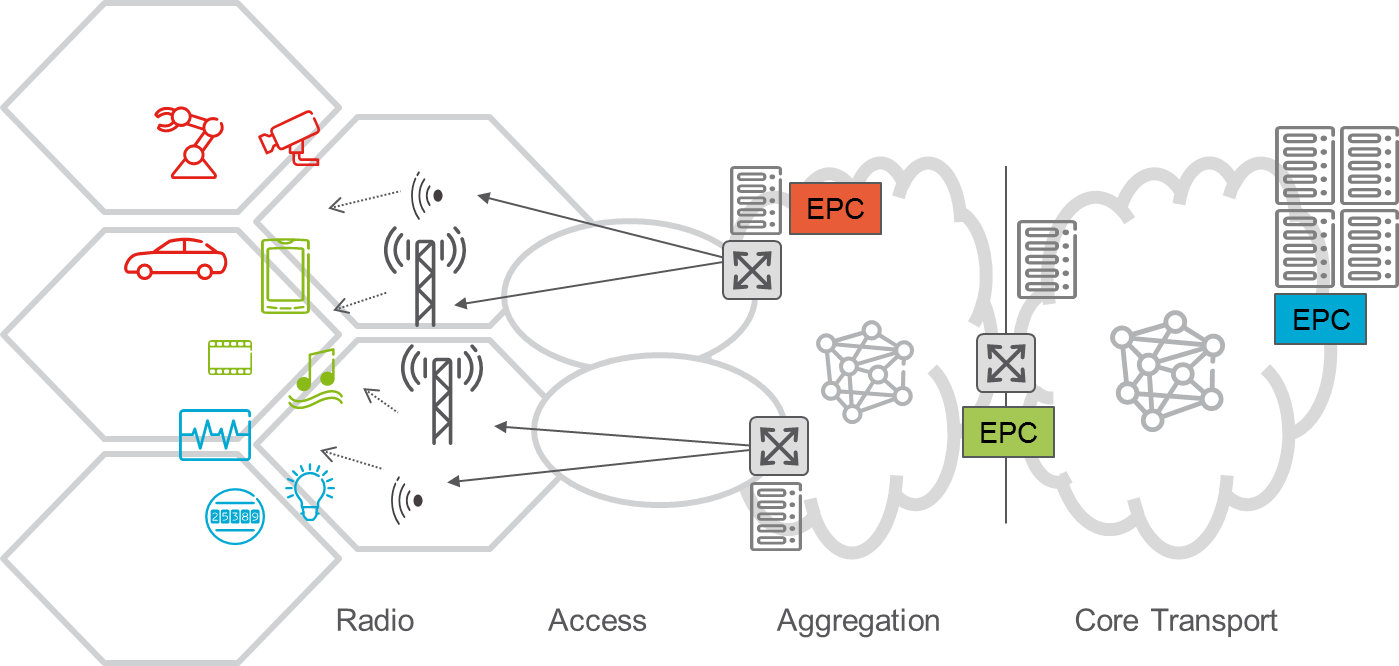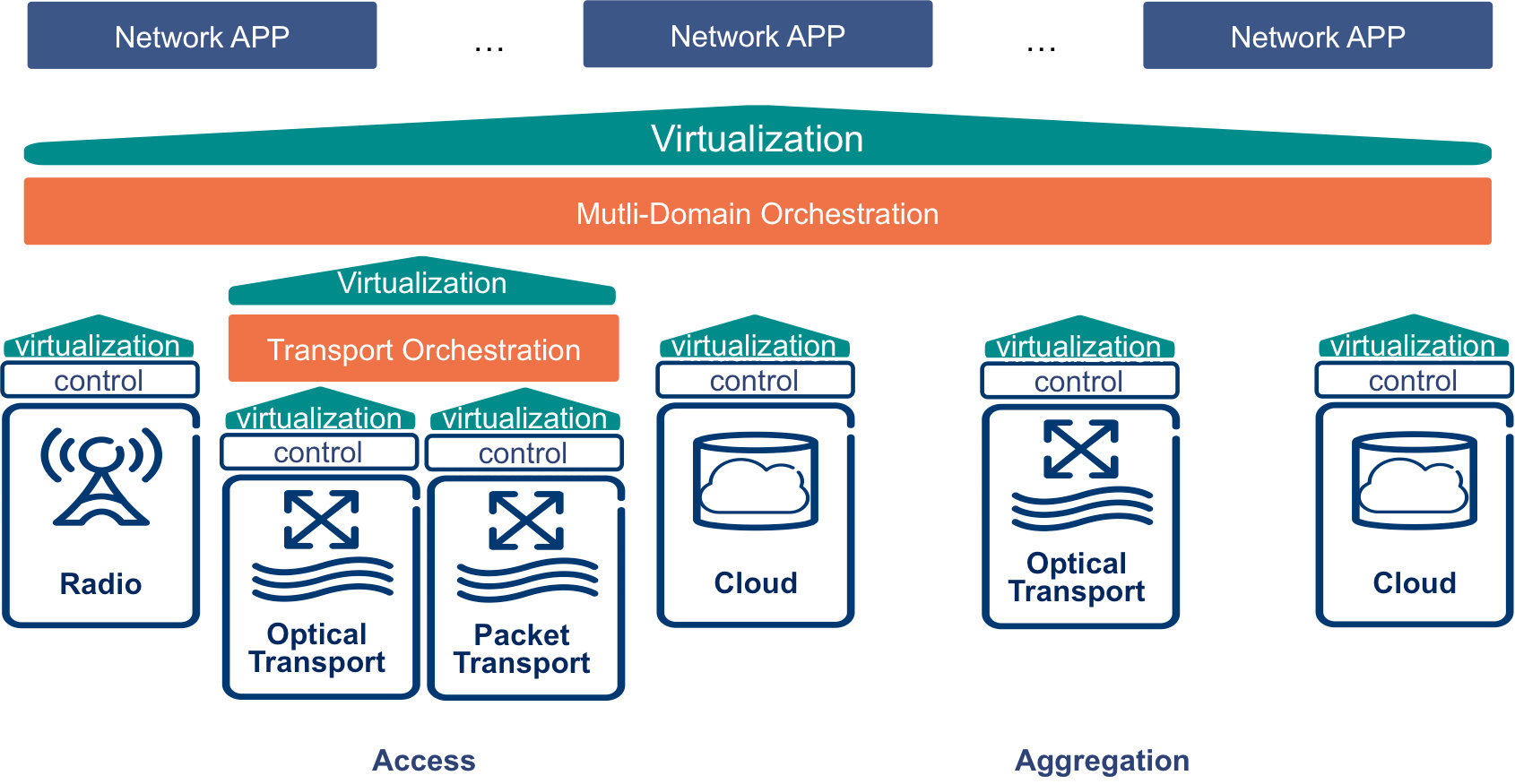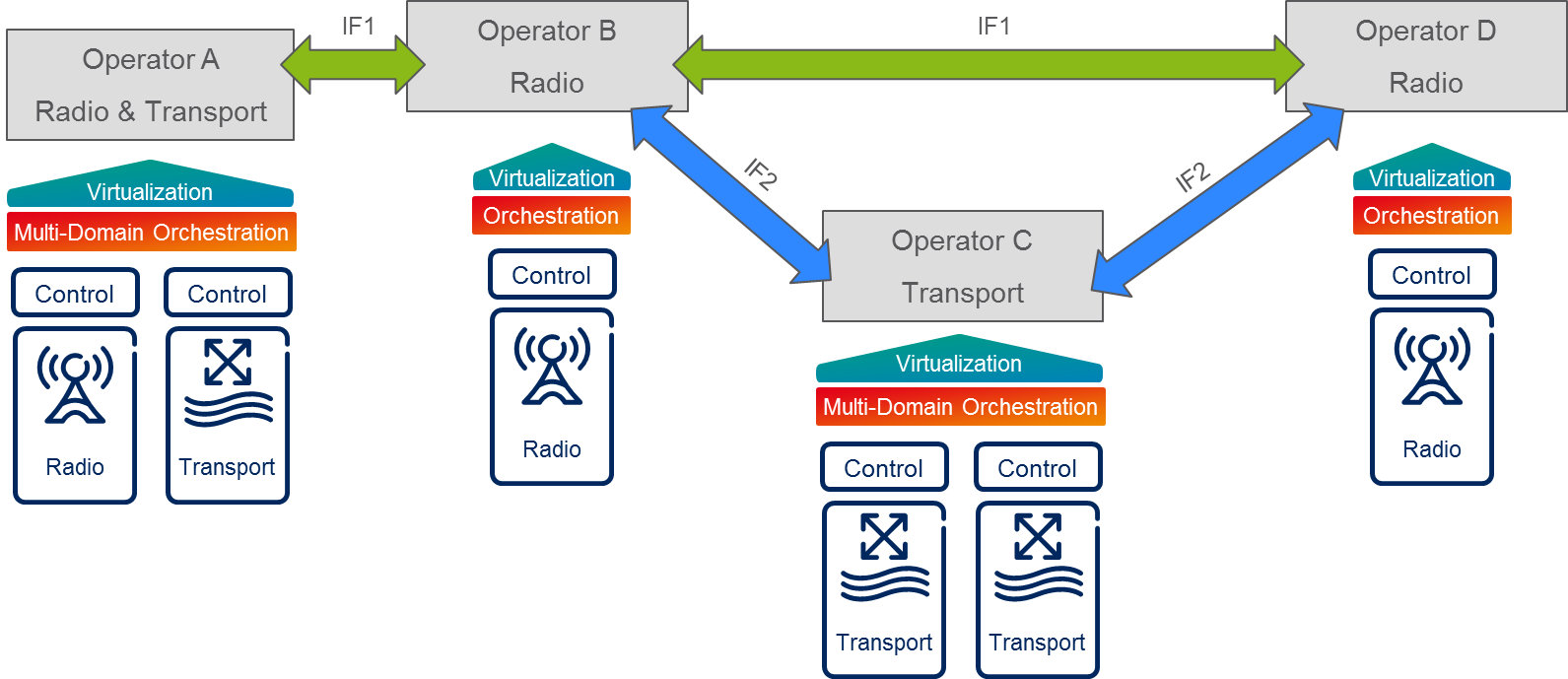Orchestration and Control Solutions in 5G: Challenges and Opportunities from a Transport Perspective
Peter Öhlén, Ahmad Rostami, and Paola Iovanna, Ericsson Research
5G, the next generation mobile system, aims to provide unlimited access to information by people and a large variety of connected devices. We will see a massive growth in both traffic and the number of connected devices. Due to the multitude of services that will emerge, flexibility across all domains of networking and service functions will be much more important than before [JLT-2016]. New services will be developed and launched in shorter time cycles than current networks allow. This applies to end-user services which will continue to develop, but an increasing share will be for different internet of things applications, spanning from sensor networks to performance-critical industrial applications.
Next Generation Mobile Networks Alliance [NGMN-WP], ITU-R, and 5G Infrastructure Public Private Partnership [5G-PPP] have concluded that bit rates up to 10 Gbps and a significant reduction in latency will be needed for the most demanding services in 5G. At the same time, networks need to be flexible enough to accommodate different services in a cost-effective manner.
In this context, software-defined networking (SDN) is a promising approach to provide the needed flexibility to serve the diverse requirements of future services.
Figure 1. Network scenario indicating location of different nodes, and slices for different applications like critical machine-type communication (MTC) (red), enhanced broadband (green) and sensor networks (blue)
End-to-end slicing
One important concept within 5G is network slicing, where a specific service is hosted within a dedicated slice containing all the physical and virtual resources needed [NGMN-slicing]. If the service requires high availability and performance characteristics like high bandwidth and low latency, the slice will be setup to fulfil these requirements, as illustrated in Figure 1. This applies both to network performance across radio and transport networks, but also characteristics and placement of network functions at the right location in a distributed datacenter infrastructure. Such a setup with more demanding requirements obviously comes at a resource cost which needs to be motivated by a business need and a corresponding value for the services provided to the end-user, e.g. a high-touch Internet of things (IoT) application. Examples of such services include control of industrial machinery, and some transportation applications where real-time control loops are operated from a remote location and a high-definition video stream is sent to an operations center.
Other IoT applications have different requirements – for example metering and sensor applications – where cost is a more challenging point. The transport network and the service functions for such applications would be setup in a different way. It leads still to the need to share the infrastructure across applications that span the entire range of requirements, giving more ways to create value and revenue from infrastructure investments. Coordinated resource allocation can also optimize the utilization and thus, the cost. So, effective methods and features for network sharing is a key enabler, and it is important that different control and management system across different infrastructure domains can work together to create end-to-end (E2E) services without manual setup and configuration. The need for network sharing leads also to the requirement of isolation between different services, to ensure that services continue to function as expected even in situation where there is overload in other services.
Orchestration and control architecture
Dynamic, automated and resource-efficient setup of E2E connectivity, as required by many use cases of 5G, is hard to realize with the rigid architecture of current networks. Software defined networking (SDN) is a promising technology to support the required programmability. While SDN principles like abstraction and programmability have been successfully adopted in individual technology domains, little has been achieved for adopting SDN for orchestration across multiple domains to create the E2E programmability.
Depending on the required level of flexibility and the acceptable level of complexity there are several possibilities for creating E2E orchestration based on SDN. Figure 2 presents an SDN-based, hierarchical, multi-domain orchestration architecture, which is designed to fulfill the requirements of 5G on programmability and operational scalability [ComMag-2016]. At the bottom layer of the orchestration architecture in Figure 2 there are resources, i.e. radio, transport and compute/storage, distributed across different domains. A domain-specific controller controls resources within an individual domain in a programmable way. The controllers expose abstract presentations of the resources in corresponding domains towards the orchestrator. The orchestrator aggregates these into an E2E presentation of abstract resources and exposes it towards various networking applications over a single, programmatic application-programming interface (API). Networking applications can utilize this API for requesting E2E services, which may span across various domains. The orchestrator is responsible for decomposing such service requests into required resources within individual domains and then asks the corresponding controllers for the required configurations. Additionally, the orchestrator will take care of mapping the E2E service level agreements (SLAs) to resource and quality-of-service (QoS) requirements within the different domains as well as the life-cycle management of different parts of services.
Virtualization layers on top of the controllers and orchestrator in Figure 2 present an important feature of the architecture. In particular, these layers allow virtualizing radio, transport and cloud resources for creating E2E slices. In this approach, different slices can be created to support networking applications with different requirements on resources. This enables sharing of the same infrastructure among multiple services in an efficient and flexible manner.
Figure 2. Hierarchical end-to-end orchestration across radio-access network (RAN), transport and cloud.
Inter-operator orchestration
In a scenario with multiple operators, there are additional issues compared to what is described above. Nevertheless, it will be quite relevant to enable cooperation between operators to provide E2E services towards the end customers. This means that agreements have to be established between operators for a full E2E service deployment, accompanied by suitable business models. For full automation, there is a need to setup such relations using new interfaces between different operators, which include clearly defined SLAs with the required QoS parameters across multiple managed networks. However, cooperation between operators is subject to both technical (e.g., heterogeneity of network infrastructure) and commercial constraints (e.g. confidentiality on resources, pricing, risk avoidance). For this reason, the multi-operator interaction cannot be seen as a straightforward extension of the multi-domain solution previously described. To provide E2E services spanning multiple operators could be difficult since a single operator does not have complete view of the network. Moreover, different operator’s strategies and conflicting interests could complicate the cooperation among operators, which is a fundamental prerequisite to jointly compose the end-to-end service. The existing solutions are based on an a priori E2E vision of all operator domains to be crossed to reach final destinations. Currently, mainly best-effort network service is supported, through the Border Gateway Protocol (BGP). The wide use of BGP would make it attractive to extend this best-effort protocol to include more granular SLA parameters for inter-domain routing. This would also simplify integration with legacy domains setting the stage for incremental upgrade of the inter-operator capabilities. However, there are important constraints in BGP, which limit inter-carrier QoS connectivity provisioning: The lack of flexibility (it is not possible to choose multiple paths between two remote autonomous systems), the scalability (enormous growth of globally advertised address prefixes) and confidentiality issues (e.g., resource state).
A possible option for multi-operator interworking could be based on a flat architecture where each operator can interface to other operator to establish their relations. Once the service relation has been setup, the runtime control can follow the hierarchical approach above, or a peer model. In Figure 3 a mix of possible scenarios for multi-operator interworking are shown providing a high level architecture, where each operator can ask for a service with clearly defined SLA. In case the operator A requests a radio service from operator B, the interface (IF1) is based on radio requirements. In case the operator B which owns no transport, requests a service from transport operator C, the interface (IF2) would specify transport parameters. In principle IF1 and IF2 could be a suitable extension of BGP to be adopted for radio and transport service request respectively, but novel interfaces and approaches could be a valid alternative.
Figure 3. Examples of possible scenarios for multi-operator interworking
Conclusions and open issues
In future networks, and in 5G in particular, the interworking and dynamic coordinated control across different technology domains, and different operators will become more important to fulfill service requirements. A key area to address is how to manage the complexity and enable programmable control and automation. Among the issues that need consideration and efficient solutions are
- Abstraction of infrastructure resources and capabilities
- Information sharing between different domains and related protocols
- End-to-end resource and service orchestration enabled by programmatic APIs
- Consideration of business models between operators to enable the required automation.
In the end, different technologies like the ones described in this letter will be needed to enable this, taking both new technologies and legacy networks into account. This will make possible a step-by-step enhancement of the joint infrastructure to fulfill the needs of future services connected over 5G.
References
[JLT-2016] P. Öhlén et al., "Data Plane and Control Architectures for 5G Transport Networks," Journal of Lightwave Technology, vol. 34, no. 6, pp. 1501-1508, March 2016.
http://dx.doi.org/10.1109/JLT.2016.2524209
[NGMN-WP] NGMN Alliance. (Feb 2015), NGNM 5G White Paper [Online]
https://www.ngmn.org/uploads/media/ NGMN_5G_White_Paper_V1_0.pdf
[5G-PPP] 5G PPP. (Mar. 2015), 5G vision: The next generation of communication networks and services [Online].
http://5g-ppp.eu/wp-content/uploads/2015/02/5G-Vision-Brochure-v1.pdf
[NGMN-slicing] “Description of Network Slicing Concept”, NGMN Alliance, version 1.0.
https://www.ngmn.org/uploads/media/160113_Network_Slicing_v1_0.pdf
[ComMag-2016] A. Rostami et al., “Orchestration of RAN and Transport Networks for 5G: An SDN Approach,” IEEE Communications Magazine, vol. 54, no. 10, Oct. 2016 (to appear).
 Peter Öhlén is a principal researcher at Ericsson Research. He received a M.Sc. degree in engineering physics from the Royal Institute of Technology in 1995. In 2000 he received a Ph.D. in Photonics, also from the Royal Institute of Technology. He has been with Ericsson since 2005.
Peter Öhlén is a principal researcher at Ericsson Research. He received a M.Sc. degree in engineering physics from the Royal Institute of Technology in 1995. In 2000 he received a Ph.D. in Photonics, also from the Royal Institute of Technology. He has been with Ericsson since 2005.
With more than 15 years of experience in telecommunications, he has worked with research and development in transport networks, network control, SDN, fiber access technologies, fiber-optic transmission, radio networks, optical and electronic subsystem design, simulation methods, project and program management. He was heavily involved in the standardization of 10Gb Ethernet and in the FSAN group for standardization of XG-PON systems. His current research focuses on network control, cross-domain orchestration and 5G transport networks.
 Ahmad Rostami is a senior researcher in networking technologies at Ericsson Research, where he leads activities in the area of programmable networks as well as control and orchestration architectures and protocols for 5G networks. Before joining Ericsson, he worked at the Technical University of Berlin (TUB) as a senior researcher and lecturer. At the university his areas of research covered network control and software defined networking (SDN) technologies. He holds a Ph.D. (summa cum laude) in Communication Networks from TUB, and a M.Sc. in Electrical Engineering (Communication Networks) from Tehran Polytechnic.
Ahmad Rostami is a senior researcher in networking technologies at Ericsson Research, where he leads activities in the area of programmable networks as well as control and orchestration architectures and protocols for 5G networks. Before joining Ericsson, he worked at the Technical University of Berlin (TUB) as a senior researcher and lecturer. At the university his areas of research covered network control and software defined networking (SDN) technologies. He holds a Ph.D. (summa cum laude) in Communication Networks from TUB, and a M.Sc. in Electrical Engineering (Communication Networks) from Tehran Polytechnic.
 Paola Iovanna received the degree in electronics engineering from the University of Roma “Tor Vergata” in 1996. From 1995 to 1997 she collaborated with the research center FUB of Rome, working on fiber-optic communications and optical networking. From 1997 to 2000 she worked in “Telecom Italia” where she was involved in experimentation of new services based on different access technologies (as XDSL, Frame Relay, optical). Since 2000 she joined Ericsson in the Research department where she dealt with networking and design solutions for packet and optical technology ( GMPLS, MPLS, Ethernet ). From 2009 to 2012 she was responsible to carry out research projects on packet and optical routing, control-plane and path computation solution. From 2012 she is responsible to define and prototype SDN solutions for multi-domain transport in collaboration with customers. In the framework of such activities she realized demonstrators and prototypes as well. From 2014 she leads research team to define transport networking and control solutions for 5G. She is actively involved in European project and is Technical Program Committee of international conferences like ECOC. She holds more than 50 patents on routing, traffic engineering systems, and PCE solutions for packet-opto networks based on GMPLS, and multi-domain SDN transport, fronthaul and backhaul solutions for 5G, and she is author of several tens of publications on either international scientific journals or conferences.
Paola Iovanna received the degree in electronics engineering from the University of Roma “Tor Vergata” in 1996. From 1995 to 1997 she collaborated with the research center FUB of Rome, working on fiber-optic communications and optical networking. From 1997 to 2000 she worked in “Telecom Italia” where she was involved in experimentation of new services based on different access technologies (as XDSL, Frame Relay, optical). Since 2000 she joined Ericsson in the Research department where she dealt with networking and design solutions for packet and optical technology ( GMPLS, MPLS, Ethernet ). From 2009 to 2012 she was responsible to carry out research projects on packet and optical routing, control-plane and path computation solution. From 2012 she is responsible to define and prototype SDN solutions for multi-domain transport in collaboration with customers. In the framework of such activities she realized demonstrators and prototypes as well. From 2014 she leads research team to define transport networking and control solutions for 5G. She is actively involved in European project and is Technical Program Committee of international conferences like ECOC. She holds more than 50 patents on routing, traffic engineering systems, and PCE solutions for packet-opto networks based on GMPLS, and multi-domain SDN transport, fronthaul and backhaul solutions for 5G, and she is author of several tens of publications on either international scientific journals or conferences.
Editor:
 Chris Hrivnak is a senior member of the Institute of Electrical and Electronic Engineers (IEEE) and IEEE Photonics Society. He is also a member of the IEEE Cloud Computing Community, IEEE Life Sciences Community, IEEE Smart Grid Community, the IEEE Software Defined Networks (SDN) Community, IEEE Internet of Things (IoT) Technical Community and the IEEE Internet Technology Policy Community.
Chris Hrivnak is a senior member of the Institute of Electrical and Electronic Engineers (IEEE) and IEEE Photonics Society. He is also a member of the IEEE Cloud Computing Community, IEEE Life Sciences Community, IEEE Smart Grid Community, the IEEE Software Defined Networks (SDN) Community, IEEE Internet of Things (IoT) Technical Community and the IEEE Internet Technology Policy Community.
Subscribe to IEEE Softwarization
Join our free SDN Technical Community and receive IEEE Softwarization.
Article Contributions Welcomed
Download IEEE Softwarization Editorial Guidelines for Authors (PDF, 122 KB)
If you wish to have an article considered for publication, please contact the Managing Editor at sdn-editor@ieee.org.
Past Issues
IEEE Softwarization Editorial Board
Laurent Ciavaglia, Editor-in-Chief
Mohamed Faten Zhani, Managing Editor
TBD, Deputy Managing Editor
Syed Hassan Ahmed
Dr. J. Amudhavel
Francesco Benedetto
Korhan Cengiz
Noel Crespi
Neil Davies
Eliezer Dekel
Eileen Healy
Chris Hrivnak
Atta ur Rehman Khan
Marie-Paule Odini
Shashikant Patil
Kostas Pentikousis
Luca Prete
Muhammad Maaz Rehan
Mubashir Rehmani
Stefano Salsano
Elio Salvadori
Nadir Shah
Alexandros Stavdas
Jose Verger






